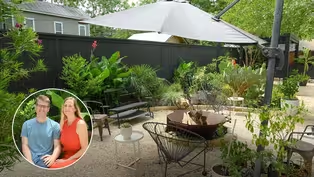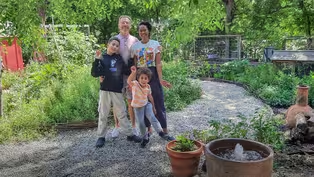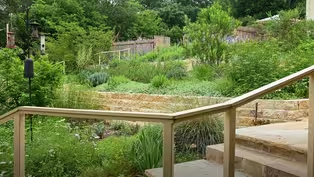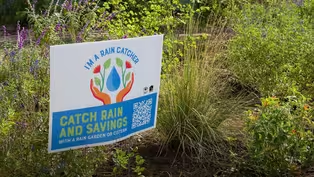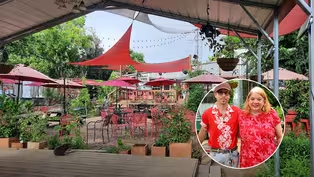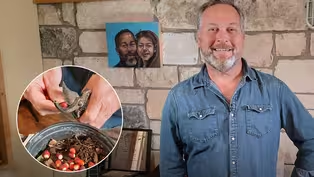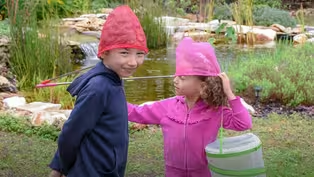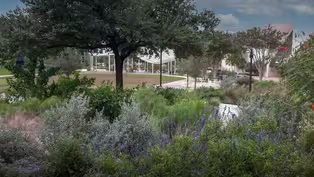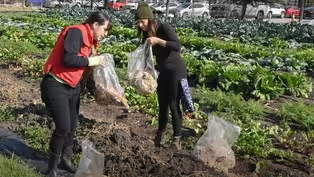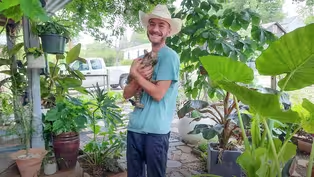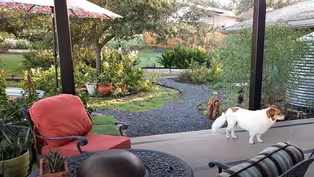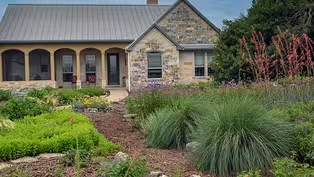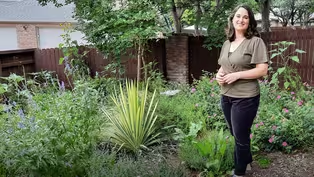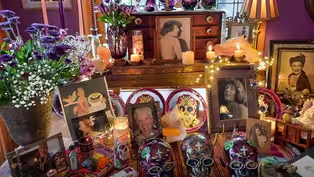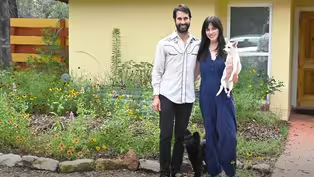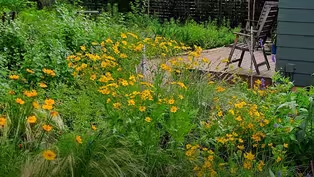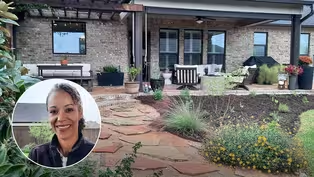
Small Yard Makeover: From Grass to Wildlife Diversity
Clip: Season 29 | 9m 30sVideo has Closed Captions
Ecologist and mycologist Chris Garza controlled flooding rain and restored the soil in a small yard.
In summer 2023’s extreme heat, Chris Garza sheet mulched his small front yard to kill Bermuda grass and invasive weeds. When he and girlfriend Bre bought their first house, Chris—an ecologist, environmental scientist, and mycologist—applied his experience in fungi, rainwater control with berms and swales, and native plants to restore soil health and wildlife diversity.
Problems playing video? | Closed Captioning Feedback
Problems playing video? | Closed Captioning Feedback
Central Texas Gardener is a local public television program presented by Austin PBS
Support for CTG is provided by: Lisa & Desi Rhoden, and Diane Land & Steve Adler. Central Texas Gardener is produced by Austin PBS, KLRU-TV and distributed by NETA.

Small Yard Makeover: From Grass to Wildlife Diversity
Clip: Season 29 | 9m 30sVideo has Closed Captions
In summer 2023’s extreme heat, Chris Garza sheet mulched his small front yard to kill Bermuda grass and invasive weeds. When he and girlfriend Bre bought their first house, Chris—an ecologist, environmental scientist, and mycologist—applied his experience in fungi, rainwater control with berms and swales, and native plants to restore soil health and wildlife diversity.
Problems playing video? | Closed Captioning Feedback
How to Watch Central Texas Gardener
Central Texas Gardener is available to stream on pbs.org and the free PBS App, available on iPhone, Apple TV, Android TV, Android smartphones, Amazon Fire TV, Amazon Fire Tablet, Roku, Samsung Smart TV, and Vizio.
Providing Support for PBS.org
Learn Moreabout PBS online sponsorship- I think a lot of my choices are just based, almost exclusively on diversity.
If you think about increasing your diversity in general and your landscape, you're gonna have seasonal interests no matter what, right?
My name's Chris Garza.
I am an ecologist and an environmental scientist.
I work for an environmental consulting firm and have worked for nonprofits in the past.
Been really interested in ecosystem restoration for a long time.
I try to take what I've learned and apply it at home to get as much diversity and wildlife in my yard as I can.
We bought this house in April of 2023, and right away there were a couple things that I knew that I had to do.
There's a ligustrum, glossy privet that I knew had to come out and a chinaberry in the back, a big chinaberry that had to come out because I was working a job where I was literally cutting these invasives out day after day.
And then I knew that I couldn't come home to a place that had two of these plants that were just producing seeds and contributing to that.
So literally, the day I was moving in, I was cutting down the ligustrum, the same day.
I had to hire somebody to take out the chinaberry because of its size.
I left snags that are, you know, not tall enough that if they were to fall over they would hurt anything.
But I wanted to be able to inoculate them with fungi.
Actually, we had a housewarming party and I made a little inoculation station at the house warming party where people could write down something that they wanted to decompose in their life, something that they wanted to get rid of.
And so they wrote it down on a little piece of paper, wadded it up, drilled a hole into the chinaberry.
They soaked the little paper in some water, pushed it into the hole, and then they put an inoculated dowel of oyster mushrooms into the hole as well.
And so they could decompose that negative thought or negative feeling that they wanted to.
So now this chinaberry's getting all soft and decomposed with everybody's, you know, negative intentions or whatever it was that they're trying to get rid of.
It's all being decomposed.
Another thing that happened at that same house warming party, these storm clouds started to roll in and everybody headed inside and it just started absolutely dumping rain.
We have a flat roof on this house.
All the water sheds to one side of the house and it was getting dropped right next to the side of the house, and the water was just trying to go any direction it could, but that also meant that some of it was going towards the house.
And so we had flooding during our housewarming party, and I was running around like crazy trying to soak up all this water that was coming into the house.
And so a lot of what I've done with the yard is not because I thought it was just something fun to do, but more so something that I felt like I had to do to prevent future flooding issues.
We're standing on kind of this excess soil that I've been excavating out by the side of my house, just trying to dig a swale to direct water away from the side of the house.
But I needed somewhere to put all this soil, so I built up a little pathway.
I've done other things.
I've extended these gutters so that the water gets dumped further from the house.
Yeah, a little bit of a nightmare for a housewarming party, but it's led to some interesting changes in our yard.
I really wanted to get rid of all these invasive species that I had, and one of the worst on my list is Bermuda grass.
I ran through all these different options in my head of solarization with plastic or herbicide or something else, some kind of disturbance like tilling the soil or something like that.
The option that I came up with, or the option that I chose, I chose because I thought that it would do the least damage to the soil and the soil life, like fungi and other microbes and macro invertebrates in the soil.
So I chose to basically bury my yard in mulch for six months to smother the Bermuda grass and all the other weedy plants.
First I did a layer of cardboard, and then I did six to eight inches of mulch.
I'm slowly decomposing that mulch using Central Texas Mycological Society's recycled mushroom block program.
So they have multiple spots around town where you can pick up mushroom blocks, you can break it up into your mulch and it'll help turn that mulch into healthy soil.
But also for me, what it did is it helped smother my Bermuda grass.
After six months of leaving mulch here and my girlfriend being very annoyed with how ugly our lawn looked, because it was no longer a lawn, it was just brown mulch, I was finally able to scoop it all away.
I still have it, you know, in various places throughout the yard, piled in different ways to utilize it as protection from the neighbors' Bermuda grass or things like that.
But then I had all this exposed soil.
I hand collected a lot of seeds from various friends of mine that have land or other private people, you know, private properties where I could collect seed, but I've also supplemented it with plugs and plants that I've bought elsewhere.
What you see in my garden is a total mix of stuff from seeds, stuff from pots, a lot of stuff I'll start also in four inch trays and grow myself in trays initially, and then once they're big enough, I'll plant them in the garden.
Just because some of the plants get out competed if you were just to seed them in the lawn first.
That side of the house where it's shadiest is also the best place I have the fireflies.
I also have a ton of snails and the firefly larvae tend to eat things like worms and snails and slugs.
So I think all those snails are probably contributing to the firefly population in the neighborhood.
A lot of people would think of the snails as a pest, and in some ways they kind of are, they chew on my plants, but they're part of the ecosystem.
And I think about that with all the pests that, you know, are on my plants, any aphids or scale insects, things like that, I've got all the other things that are eating them too.
So I want to support not just, you know, the pollinators and the pretty butterflies and bees.
I want to support the aphids because they support ladybugs or, you know, praying mantises and other insects like that.
One of the great things about using mulch was seeing all the different fungi that utilize mulch.
Not only fungi, but slime molds too.
I see a tons of inkcaps in my yard.
I've seen the spring polypores, Xylaria, the candlesnuff fungus, or some people call it a dead man's fingers.
There's all types of fungi, and most of them really aren't edible, but they're still super fun to see.
There's a good chance that they're decomposing that mulch and basically in doing that, they're making the mulch more bioavailable for the plants to take up.
So they're, if you think about, you know, a rough cut mulch, these are pieces of wood that are too hard for another plant to take up nutrients from.
But if something else could come in there and break down that wood into something smaller and more, you know, bioavailable, all of a sudden these plants can take up nutrients, they can take up minerals that were locked in that mulch.
I've been interested in fungi for, I guess, 15 years or so now.
I used to work at the Houston Arboretum and Nature Center, and when I was there, I used to walk the trails and I'd see different fungi every time I took a walk.
And I got really interested in what those fungi were and the roles they played in the ecosystem.
And so I'd research that when I'd get back to the office.
And then I found a group of like-minded people with Central Texas Mycological Society, and I've been involved with them ever since.
And we go out and teach people about fungi and all different aspects of fungi.
When I take my dogs for a walk, I think about what am I not seeing in my neighborhood that's still native and it's not common in the neighborhoods.
When I first moved in, before I covered my yard with mulch and everything, I did an inventory of all the plants that I could find on my property.
Now my goal every spring is to do another inventory and see what's changed.
I've classified things into whether or not they're native, invasive or naturalized, or whether they were planted, or whether they just showed up on their own.
It's been really fun to track the changes in my yard, even though it's only been, you know, one season, it feels like there's been a lot of changes.
I want to contribute, not just to the diversity of my yard, but to the diversity of the neighborhood.
Contemporary Courtyard Makeover
Video has Closed Captions
Clip: S29 | 9m 29s | In a ground-level makeover, a young couple went for outdoor living and wildlife habitat. (9m 29s)
Blank Yard to Wonder-Filled Gardens
Video has Closed Captions
Clip: S29 | 8m 54s | Richie and Nkiru Gelles applied muscle and imagination to turn their backyard into a lively habitat. (8m 54s)
Garden Design: Plant Communities for Wildlife
Video has Closed Captions
Clip: S29 | 9m 27s | On an old lot, new owners envisioned an urban wildlife sanctuary for year-round beauty. (9m 27s)
Rain Gardens: Catch and Hold Runoff Water
Video has Closed Captions
Clip: S29 | 7m 55s | See how to create a rain garden with beautiful native and adapted plants for pollinators. (7m 55s)
Butterfly Garden Performs at Repertory Theater
Video has Closed Captions
Clip: S29 | 9m 14s | An urban butterfly sanctuary restores life to soil and soul in daily pollinator performances. (9m 14s)
Easy Way to Germinate Texas Mountain Laurel Seeds
Video has Closed Captions
Clip: S29 | 3m 40s | Get the secret to success with Billy Garza. (3m 40s)
Music to Your Ears: Food, Fun, Family
Video has Closed Captions
Clip: S29 | 7m 37s | Musicians and home-schoolers Lisa and Shane Lamb grow their garden goals one weekend at a time. (7m 37s)
Parking Lot to Wildlife Habitat Park: St. John Encampment
Video has Closed Captions
Clip: S29 | 8m 22s | Once crowded with cars, this former mall parking lot now gathers another kind of community (8m 22s)
Grow Soil Health with Mushroom Blocks
Video has Closed Captions
Clip: S29 | 4m 35s | Smash and mulch recycled mushroom blocks for healthy, productive plants. (4m 35s)
Garden Love Germinates at Rental House
Video has Closed Captions
Clip: S29 | 7m 44s | Cyrano Carroll wasn’t keen on digging in until a chance opportunity changed his life. (7m 44s)
Video has Closed Captions
Clip: S29 | 9m 17s | Kat and Dave Sherby fell for a big yard that beckoned creative brainstorming for wildlife watching. (9m 17s)
From Cattle Ranch to Wildlife Paradise
Video has Closed Captions
Clip: S29 | 8m 42s | These days, wildlife graze four acres of native plant gardens on former ranchland in Jarrell. (8m 42s)
Drought-tough Cottage Design with Native Plants
Video has Closed Captions
Clip: S29 | 8m 11s | Alexa Volpe never knew that gardening could be so hard until moving to rocky soil in San Antonio. (8m 11s)
How Biking Led to No Lawn Native Plants
Video has Closed Captions
Clip: S29 | 8m 43s | Biking along country roads inspired Laura O’Toole to rip out lawn for beautiful native plants. (8m 43s)
Celebrating Life on Day of the Dead
Video has Closed Captions
Clip: S29 | 8m 11s | Dia de Los Muertos pays tribute to our lost loved ones who influenced our lives, souls, and culture. (8m 11s)
Small Yard Makeover: From Grass to Wildlife Diversity
Video has Closed Captions
Clip: S29 | 9m 30s | Ecologist and mycologist Chris Garza controlled flooding rain and restored the soil in a small yard. (9m 30s)
Three Stories of Change: Wildflower Pocket Gardens
Video has Closed Captions
Clip: S29 | 9m 23s | Pollinators and birds waltz around native plants where lawn grass once dominated. (9m 23s)
Less Lawn, More Wildlife, Lessons Learned
Video has Closed Captions
Clip: S29 | 9m 23s | Natalie McAnarney’s family spends more time in the backyard since she swapped dull for enchanting. (9m 23s)
Providing Support for PBS.org
Learn Moreabout PBS online sponsorship

- Home and How To

Hit the road in a classic car for a tour through Great Britain with two antiques experts.












Support for PBS provided by:
Central Texas Gardener is a local public television program presented by Austin PBS
Support for CTG is provided by: Lisa & Desi Rhoden, and Diane Land & Steve Adler. Central Texas Gardener is produced by Austin PBS, KLRU-TV and distributed by NETA.
